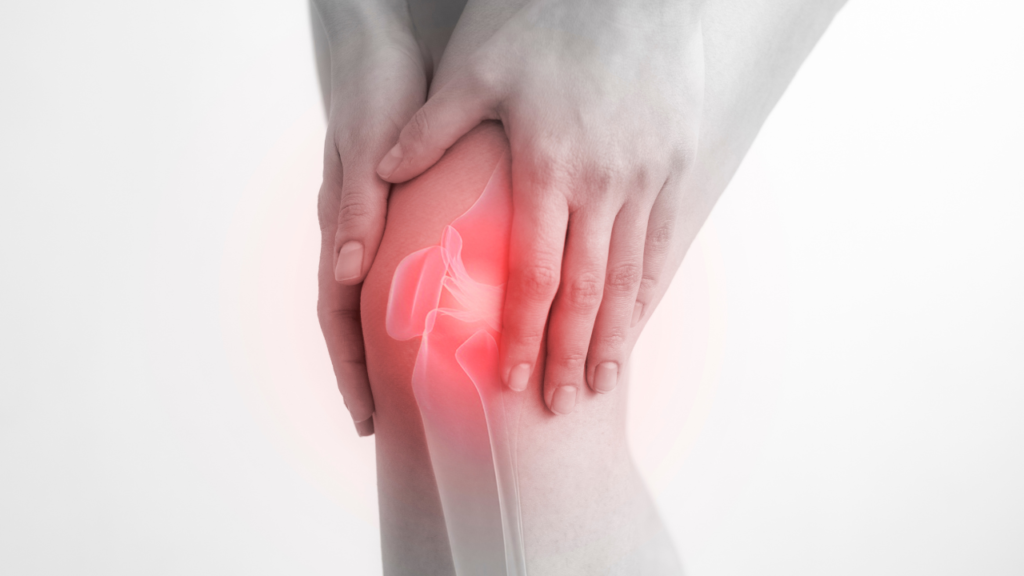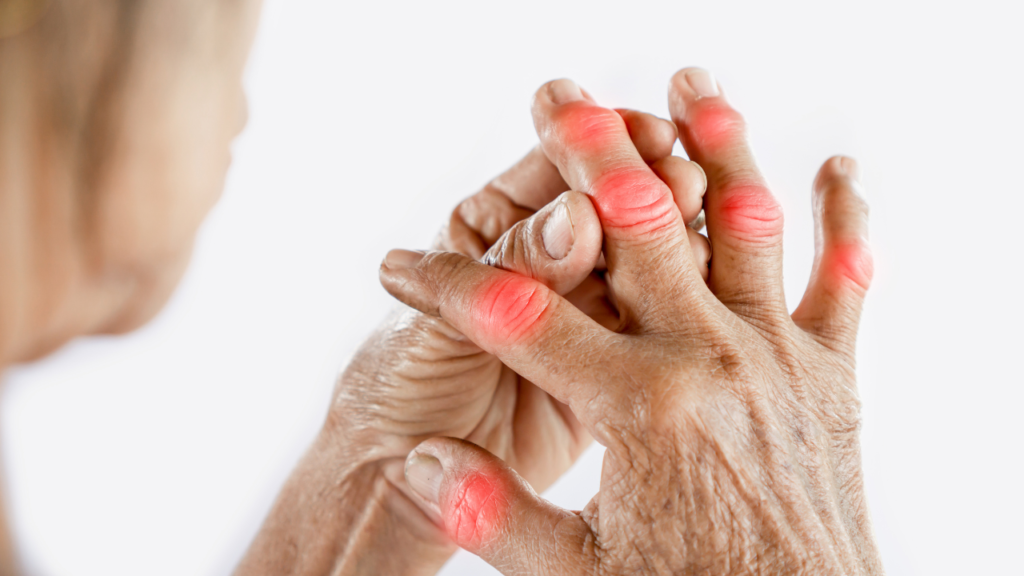
Joint pain is when body parts that are your joints, like your hands, feet, hips, knees, or neck, hurt. Sometimes the pain hurts all the time, and sometimes it comes and goes. Your joints might feel stiff, achy, or sore. Some say it feels like a burning, throbbing, or “grating” feeling when trying to describe the pain. Your joints might be stiff in the morning, but they can feel better when you move around.
Joints are the places in your body where your bones come together. Joints help your bones move. Some examples of joints are your shoulders, hips, elbows, and knees. When we talk about joint pain, we mean when these places hurt or feel uncomfortable. Lots of people feel joint pain sometimes. Usually, you don’t need to go to the hospital for it. Sometimes, joint pain happens because of an illness or injury. Arthritis is a common reason for joint pain, but there can be other reasons, too.
Joint pain can make it hard to use your joints and do everyday things. If the pain is terrible, it can make your life less enjoyable. To make joint pain better, it’s good to know how joints work and heal. Also, it’s important to reduce inflammation that can harm joints and cause pain. If you’re interested in a natural way to understand and treat joint pain, including options like injections, anti-inflammatories, and ways to improve joint function, join the Confident Hormone Club now. You’ll get helpful info to make your joints stronger, so you can move better and do more activities.
Causes of Joint Pain
- Adult Still disease
- Ankylosing spondylitis
- Avascular necrosis (osteonecrosis)
- Bone cancer
- Broken bone
- Bursitis
- Complex regional pain syndrome
- Depression (major depressive disorder)
- Fibromyalgia
- Gout
- Hepatitis B
- Hepatitis C
- Hypothyroidism (underactive thyroid)
- Juvenile idiopathic arthritis
- Leukemia
- Lupus
- Lyme disease
- Osteoarthritis
- Osteomyelitis
- Paget’s disease of bone
- Polymyalgia rheumatica
- Pseudogout
- Psoriatic arthritis
- Reactive arthritis
- Rheumatic fever
- Rheumatoid arthritis
- Rickets
- Sarcoidosis
- Septic arthritis
- Sprains
- Tendinitis
Joint pain symptoms
Sometimes, the joint can feel tight, hurt, or ache. Some people say it’s like a burning or throbbing feeling or like something is rubbing inside. Also, in the morning, the joint might feel stiff, but it gets better when you move around and do things. Joint pain happens more often in individuals who:
- Previous injury in joint.
- Use a muscle too much or do repetitive movements.
- Have conditions like arthritis or other long-lasting health problems.
- Experience feelings of sadness, worry, or stress.
- Obseity or overweight.
- Aren’t in good health.
- Worse stiffness and walking after moving over the age of 45.
- A joint that feels hot, swollen, and hurts more when you touch it or move it.
- You are feeling achy and stiff on both sides of your body, especially when you haven’t moved for a while, like when you wake up in the morning.
- A joint that’s red, puffy, and warm, and also having a high temperature or feeling feverish and chilly.
Understanding the OA and RA

One of the main reasons people have joint pain is because of a condition called arthritis. There are two main kinds of arthritis:
- Osteoarthritis (OA)
- Rheumatoid arthritis (RA)
Osteoarthritis (OA)
OA is often seen in adults who are over 40 years old, according to the report of the American College of Rheumatology. It happens slowly and mainly affects joints we use a lot, like the wrists, hands, hips, and knees. When you have OA, the cushion-like stuff in your joints, called cartilage, breaks down, and that’s what makes your joints hurt.
The other type, Rheumatoid Arthritis, RA, is more common in women than men. RA can make your joints bend and get weaker over time. It causes pain, swelling, and extra fluid in your joints because your body’s defense system attacks the lining inside your joints, called synovial tissue.
OA tends to affect commonly used joints like fingers, spine, hips, and knees. Joint pain is the most common sign of OA, and it typically occurs after a lot of activity or by the end of the day.
Symptoms
- Symptoms of OA include joint pain and stiffness, swelling around the joint, and sometimes a cracking or grinding sound when moving the joint.
- Sometimes, other health problems that also cause joint pain can be mistaken for OA, so it’s essential to get the correct diagnosis without unnecessary tests.
How to treat OA?
It’s good to know that our naturopathic doctors at the Make Care Health clinic can help manage OA. There isn’t a cure for OA, but you can make it less bothersome for you and prevent progression. Here are some actions you can take:
- Make sure your neck and back are in good positions when you sit or sleep.
- Adjust your furniture, like raising a chair or toilet seat, to make it easier to use.
- Try not to do the same movements over and over again with the joint that hurts.
- If you’re overweight or obese, losing some weight can help reduce pain and slow down OA.
- Exercise a little bit every day.
- Use tools or devices that can make everyday tasks easier.
Causes of Rheumatoid arthritis
In a healthy body, the immune system helps protect us from harmful things like germs. But in a condition like RA, the immune system makes a mistake. It thinks our body’s cells are the bad guys and sends out chemicals that cause inflammation and attack those cells. In RA, it targets a part called the synovium, which is like a soft lining around our joints that helps them move smoothly.
When the synovium gets all swollen and thick from this attack, it makes the joint hurt and looks red and puffy, and it’s tough to move the joint. Scientists aren’t sure why some people get RA. They think it might be because of specific genes that get turned on by something outside the body, like a virus, stress, or other things that happen in our environment.
Symptoms
In the beginning, when someone has RA, their joints might not look red or swollen, but they could feel sore and hurt. Here are some things that can show a person might have RA:
- Pain, tenderness, swelling, or stiffness in their joints that sticks around for six weeks or more.
- Feeling stiff in the morning for at least 30 minutes.
- More than one joint hurts.
- The smaller joints, like wrists and some in the hands and feet, hurt first.
- The joints on both sides of the body hurt in the same way.
- Lots of people with RA also feel very tired, and some might have a slight fever. RA symptoms can come and go, like having good days and bad days. When there’s a lot of swelling and other symptoms, it’s called a “flare,” and it can last for a little while or a long time.
Treatment of RA
A naturopathic doctor at Make Care Health can help with these goals. The aims of treating RA are:
- Stop inflammation or make it as little as possible (called remission).
- Ease the symptoms.
- Prevent damage to the joints and organs.
- Make the person able to move and feel better.
- Lower the chances of problems in the long run.
To do these things, the naturopathic doctor will:
- Check how much inflammation there is and what things might be causing it in the body. Keep an eye on both the facts (objective data) and how the person feels (subjective data) during treatment.
- Start treatment early and be firm to lower or stop inflammation as soon as possible.
- Set a goal to reach remission or another target, aiming for fewer or no signs of inflammation.
- Keep a close eye on inflammation as low as possible.
How to treat joint pain at home?
Both OA and RA are long-lasting problems, and there’s no cure for the joint pain they cause. But there are ways to make the pain better:
- You can try creams or pills that help with pain and swelling.
- Keep moving and do some moderate exercises to stay fit.
- Stretch your body before exercising to make sure your joints can move well.
- Try to keep your body weight in a healthy range to not put too much pressure on your joints.
- If your pain isn’t from arthritis, you can take over-the-counter medicine, get a massage, take a warm bath, stretch often, and get enough rest.
Naturopathic treatment of joint pain at MakeCareHealth Clinic
Joint pain can happen because of regular wear and tear on your body. But sometimes, it might mean there’s an infection or a more severe problem like RA. A naturopathic doctor can help manage joint pain through natural approaches, such as dietary recommendations, herbal remedies, and lifestyle changes.
They focus on holistic healing to reduce inflammation, improve joint mobility, and enhance overall well-being. When naturopathic doctors find out what’s causing the pain early on, they can treat it better. Optimize Your Well-being with Our Online Store! Canadian customers, sign in to uncover a meticulously curated selection of health products. Join now to enjoy teas specifically chosen to enhance your health journey.

